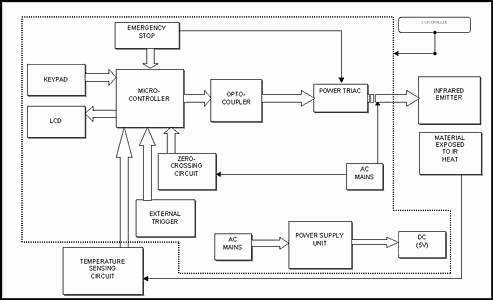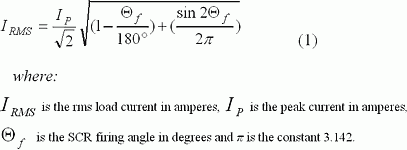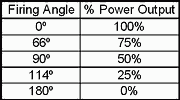
Ref: z2615193m
In this paper an IR heating profile controller system is designed. The circuit design uses power electronics techniques to accomplish phase angle delay power control of an Elstein FSR2-125 IR ceramic element. By the use of this circuit it is envisaged that domestic and industrial processes employing infrared technology will be made more efficient and robust.
Introduction
Infrared heating and processing is being used increasingly in many industrial processes because of the greater variety of benefits this type of heating provides [1]. Applications are found in industries involved in curing [2], drying [3] and heating [4].
This paper presents an overview of one of the power control methods investigated. The phase angle technique is a widely used method of power control in many industrial designs. The programmable controller designed in this paper has the capability to vary the output power of an infrared emitter or emitters interfaced to it. It is this ability of the controller that makes it useful for various industrial processes employing infrared heating [1]. The design of the infrared heating profile controller is microprocessor-based and therefore software-programmable.
Although the concept presented is aimed at the industrial market, domestic applications are possible. IR heating could be an alternative to microwave or convection ovens. A modification of the circuit and hardware aspects presented, could result in a viable unit for domestic use [5].
Controller operation
The infrared heating profile controller is designed around the Siemens SAB 80C535 microcontroller that is based on the 8051 architecture. This is an 8-bit CMOS chip that includes the following features; six 8-bit I/O ports, three 16-bit timer/counters; 12 interrupt vectors, as well as an 8-bit A/D converter.
The block diagram for the control system of the controller is presented in Figure 3. The infrared heating profile controller is designed to function in the following manner: via the input user-interface (keypad) the user enters a desired heating profile which has been previously determined, when prompted to do so on the output user-interface (LCD). Each profile is entered in two phases firstly in terms of the required output temperature of the material and secondly in terms of the time a particular profile should last. This information is stored in the microcontroller, which in turn determines the firing angle of the power triac connected to it. However before this pulse is sent to the triac, the microcontroller waits for a signal from the zero-crossing circuit so as to ensure the accuracy of the firing angle.

Once this signal is received, the microcontroller pulses the triac (SCR), which fires at a particular angle and consequently regulates the input voltage to the IR emitter. The mains voltage circuitry is optically isolated from the rest of the circuit ensuring protection of electronic circuitry as well as for the operator. The circuit includes an on-board 5 V d.c. power supply unit. Included is an external trigger, which allows a particular profile to be repeated.
For more effective control of the entire process an accurate measurement of the temperature of the material exposed to the infrared heat is desirable, this is done with the help of a pyrometric sensor. This sensor is interfaced to the microcontroller through the on-board A/D converter.
It should be noted that to comply with safety standards an emergency stop facility is installed, which will provide the user a manual and useful means to control the entire process. Upon visual inspection or through alarms generated an emergency stop could be implemented. This is also an added safety feature should anything unforeseen happen.
Hardware overview
Power control aspects
This design uses silicon controlled rectifier (SCR) technology to achieve power control, because SCRs provide a wide range of advantages as opposed to the mechanical devices traditionally used. These advantages include high reliability, extremely fast response, selectable control parameters and low maintenance [6].
An SCR does not conduct until its gate terminal is triggered by a DC pulse or series of pulses. Once triggered into conduction it continues passing current even if the trigger pulse is removed. However the current ceases when the applied AC voltage goes through a zero crossing and requires another trigger pulse before the SCR will conduct.
The r.m.s. load current is given by [7]:

The effect of phase angle delay on the load (assuming a resistive load) is illustrated in Figure 1. By varying the firing angle of the SCR, the load power is varied accordingly. The firing angle can be adjusted from near 0° to near 180°. This prototype circuit is intended for single-phase applications but is easily adapted to function in three-phase systems as well.
![Figure 1. Phase angle fired SCR control [5]](articles/Dataweek - Published by Technews/z2615193m1.gif)
Table 1 illustrates the relationship between the firing angle and the resultant power output. (With Vac = 220 V rms and RL = 300 Ω). When the program stored in the microcontroller's memory is executed, the software program waits until it receives a zero-crossing signal from the voltage comparator. This action also eliminates any RFI (radio frequency interference) that could occur. A differential amplifier precedes the input to the voltage comparator. The differential amplifier ensures that the signal ground of the input ac voltage is isolated from the earth ground of the electronic circuitry in the rest of the circuit.

The firing signal from the microcontroller triggers an opto-triac that in turn triggers the power triac. The control mode chosen was phase-angle delay although the burst firing technique should work equally well.
Closed loop control
In order to monitor the output temperature of the material radiated by the infrared emitter a pyrometric sensor (pyrometer) is used for temperature feedback. The sensor's linear voltage output facilitates interfacing to the on-board A/D converter of the microcontroller. Optical sensors like the pyrometer are the preferred method of temperature measurement as opposed to thermocouples in certain industrial applications [8].
This temperature measurement is compared to the desired input temperature available from the heat profile information. By means of the control algorithm, the error generated by the difference of the two temperatures is compensated for and adjusted. The control algorithm regulates the heating process with the result being that the output temperature closely follows the desired one. The simplified control diagram for the system is presented in Figure 2.

The transfer function for the system shown below can be described by the following:

Through negative feedback the system is made more stable. Because the mathematical model of the plant is not known on the onset, a PID controller is chosen that would meet the transient and steady-state conditions of the closed loop system.
Software overview
Using assembler as well as programming in the C language accomplished the software programming of the microcontroller. The control program is stored in an on-board EPROM. The feature of software programmability makes this unit versatile and adaptable. So that as the output parameters or the process change, by re-programming the software the controller adapts accordingly.
The software program is sub-divided into many routines that process the specific tasks required. For instance one routine calculates the firing angle needed for a required emitter output temperature. Another routine stores the range of temperatures and times into on-board RAM.
Conclusion
The design aspects of an infrared heating profile are presented. There are many different elements that had to be considered in the design of this IR controller. These include; what hardware platform to choose, what type of power control to implement and what type of control algorithm is best suited for the application. With this in mind there are a range of modifications that could be tried and implemented. The design concepts presented represents a starting point for further research, with definite possibilities for the domestic market. Indeed in this regard the domestic arena is an untapped research area that offers a feasible market potential.
Acknowledgement: The author would like to thank the NRF (National Research Foundation) for their financial support for the project, GUN 2040624 under which this paper's topic was realised.
References:
[1] Adonis, M and Khan, MTE.: "Infrared Heating Profile Controller" Proceedings of the 3rd International Conference on Control Theory and Applications, Pretoria, South Africa, Dec. 2001, pp.445-449.
[2] Anonymous: "Powder Coat: Better system = improved results" Modern Metals, Aug. 1993, pp.76-80.
[3] Zhao, Y and Broadbent, A: "Fixation of Reactive Dyes on Cotton Using Infrared Radiation" Canadian Texile Journal, April 1993, pp.32-38.
[4] Lavitt, M: "Infrared Deicing Technique Called Ready For Operational Use" Aviation Week & Space Technology, Sep. 1996, pp.104-105.
[5] Anonymous: " Explosive Cooking" Discover, Vol. 19, No. 10, Oct. 1998, pp. 32.
[6] Technical brochure: "Control IR" SCR Power Controllers, Research Inc., U.S.A., Jan. 2001, pp.1-4.
[7] Bogart, T.F: Electronic Devices and Circuits, 3rd Edition, Macmillan, 1993, pp.854.
[8] Technical brochure: "Infrared Thermometer Selection Basics" Process Heating, 2000, available at http://www.processheating.com/CDA/ArticleInformation/coverstory/BNPCoverStoryItem/0,3154,13502,00.html
Bibliography:
[1] Knights, M: "Tumbling Clamshell Oven puts new spin on Rotomolding" Plastics Technology, April 1997, pp.35.
[2] Anonymous: "Infrared Heating Systems Offer Dry/Cure Advantages" Adhesives Age, Oct. 1996, pp.30-31.
[3] Foster, A: "Infrared Can Take The Heat" The Engineer, June 1996, pp.22.
[4] Cox, N.R. and McGee, D.E.: "Use of High Density IR for the Rapid Heating of Metals" Industrial Heating, April 1989, pp.46-48.
[5] Knights, M: "Thermoformers Give Glowing Reviews To Halogen Heat Lamps" Plastics Technology, Jan. 1997, pp.16.
About the authors:
Principal Author: Marco Adonis holds an MTech degree in Electrical Engineering from Peninsula Technikon.
Co-author: Dr M.T.E. Khan is a researcher of infrared and optical sensor applications and a supervisor of research projects at Peninsula Technikon.
The above paper was based on the presentation at the International Conference on Domestic Use of Electrical Energy, March 2003.
Information provided by Peninsula Technikon

© Technews Publishing (Pty) Ltd | All Rights Reserved